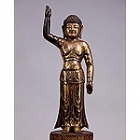Japanese Archaeology and Special Exhibition (Heiseikan) Special Exhibition Galleries
October 8, 2010 (Fri) - December 12, 2010 (Sun)
The Great Buddha of Todaiji temple in Nara was initially built over 1250 years ago by order of Emperor Shomu and Empress Komyo as a prayer for peace in Japan and the world beyond. Featuring works related to the Great Buddha, this exhibition looks into the spiritual aspects of the project, as well as the essence of Tenpyo-era culture. Exhibits will include: bronze panels from the octagonal lantern in front of the Great Buddha Hall, votive objects, Gigaku masks used during the eye-opening ceremony of the Great Buddha, the largest ancient example of a "Buddha at Birth" sculpture produced in Japan, a portrait statue of the temple's first head priest Roben who devoted himself to the building of the Great Buddha, and sculptures of deities who, according to legend, manifested themselves as Buddhist priests and supported the project.
Additional masterpieces such as portrait sculptures of the priests Chogen and Kokei who contributed to the temple's revival in the middle ages express the enduring cultural importance of the temple.




















